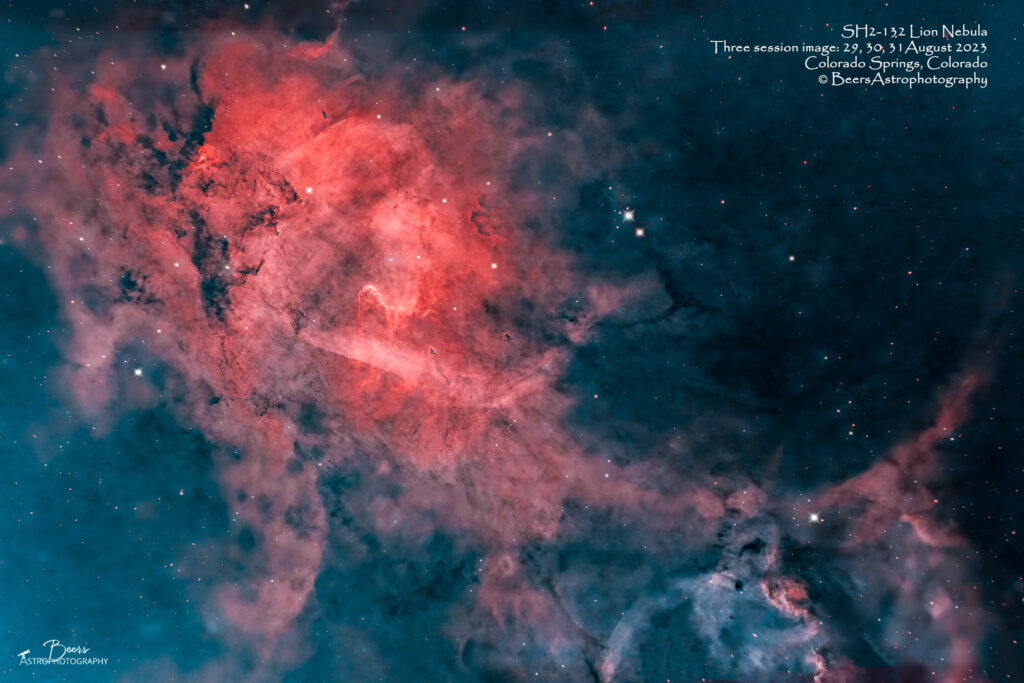
Fun facts
Sh2-132 is a large emission nebula in the constellation Cepheus. It is located on the southern edge of the constellation, a short distance from the boundary with the Lizard, along the plane of the Milky Way. Sh2-132 is located at nearly 3200 parsecs (almost 10400 light-years), placing it within the Milky Way’s Perseus Arm. The stars responsible for the ionization of its gas are very hot and massive; in particular, two Wolf-Rayet stars have been identified, known as HD 211564 and HD 211853 (the latter also having the abbreviation WR 153), as well as a spectral class O8.5V star and about ten B-class stars.
Other Catalog Designations: LBN473
Subtype: HII region
Distance from Earth: 10,400 light years
Apparent Size: 1°20’ x 1°10’
Constellation: Cepheus
{Target information derived from: https://telescope.live/gallery/sh2-132-lion-nebula and Stellarium }
Capture Notes
On Saturday morning in the Beast, after finishing the stacking of SH2-126, before turning off the SC laptop, I did the target selection for Saturday night (6Jul2024) from my list. I had planned to image IC4604 Rho Ophiuchi Nebula and then switch to SH2-132 Lion Nebula. After looking at IC4604 – I decided it was too low (only rose to 28 degrees) and too big (requires 2-tiles). In other words, I only had about 4 hours of questionable visibility to capture two frames. So I decided to forego, move IC4604 to my Southern Hemisphere target list for March 2025, and spend the full night on SH2-132 Lion Nebula.
During the day on Saturday (our last night in camp before an early departure for home on Sunday to beat the 4th of July traffic), I decided to disassemble and put away the autofocusers both to facilitate the early morning departure and because they had not working correctly throughout the trip anyway. I’d read the SGP EAF instructions for doing a ~20 minute test (with the caveat that you needed patience!) and decided that I would do the suggested test to figure out the optimal step size (the instructions also suggested that you should use 9 steps unless you “have a reason not to”) when I am not burning dark skies time.
Equipment
Equipment: All equipment controlled by HP Probook running Sequence Generator Pro v4.4.0.1339.
- Imaging (ASI2400-SC): ZWO ASI2400MC imaging camera on (Southern Cross) Askar FRA600 108mm f/5.6 Quintuplet Petzval Flat-Field Astrograph
- Autofocuser: ZWO EAF Electronic Automatic Focuser – (EAF-5V-STD) Did not use the autofocuser. Disassembled and put them away before the last night of imaging to facilitate the early morning departure (and they were not working correctly throughout the trip anyway).
- Mount: Rainbow Astro RST-135E (controlled by iHubo ASCOM driver)
- Polar alignment: QHYCCD camera (controlled by Polemaster for polar alignment)
- Autoguiding: Orion 60mm Multi-Use Guide Scope with Orion StarShoot AutoGuider Pro Mono Astrophotography Camera (controlled by PHD2)
Capture & processing notes
Sequence Plan (4Jul2024): Gain: 158, Temp: -0°C, offset=30. 72x5min. Captured 6Jul2024, 2206MDT – 7Jul2024, 0425MDT. Total exposure time: 6:00hrs (360min, ASI2400-SC)
Shooting location: BLM land near Powderhorn, Colorado
Processing: Captured in SGP, stacked in APP (Adaptive Airy), star removal with Starnet++, processing with LR/PS
Other images of SH2-132 Lion Nebula

Capture Notes
This image is the product of three night’s imaging from my front patio in Colorado Springs, Colorado (29-31 August 2023 – YES in the midst of the full Blue Moon!). This was the first time I’ve used my ZWO ASI2400MC camera on Big Bertha (RC-8” telescope). Thus, as is common when we change things, there were three lessons learned over the three nights of imaging. The full story is in the blog section of this website, (https://beersastrophotography.com/photography-journals/new-equipment-configuration-learning-experience/) but the short story is: 1) this configuration needs more backspacing to focus with another extension tube piece; 2) this configuration does NOT need a field flattener; and 3) when the car battery used for DC power dies, if will give you zero warning. There was also a wonderment, yet to be solved/learned from…when you have three different places to set a parameter in your control software, there’s no telling which one the SW will chose to use during execution!
Equipment
Polar alignment: QHYCCD camera (controlled by Polemaster)
Imaging: (Big Bertha) Orion 8″ f/8 Ritchey-Chretien Astrograph Telescope, ZWO ASI2400MC imaging camera, Optolong LeXtreme light pollution filter
Mount: SkyWatcher EQ6‑R PRO Synscan mount (controlled by ASCOM driver)
Autoguider: Orion 60mm Multi-Use Guide Scope, Orion StarShoot AutoGuider Pro Mono Astrophotography Camera (controlled by PHD2)
All equipment controlled by HP Probook running Sequence Generator Pro v4.2
Capture & processing notes
Sequence plan (29Aug2023): Gain: 158, Temp: -0°C, offset=30; 73x5min. Total exposure time: 6:05hrs. (With field flattener: 38x5min; 3:10hrs.; Without field flattener: 35x5min, 2:55hrs.)
Sequence plan (30Aug2023): Gain: 158, Temp: -0°C, offset=30; 36x5min. Total exposure time: 3hrs.
Sequence plan (31Aug2023): Gain: 158, Temp: -0°C, offset=30; 57x5min. Total exposure time: 4:45hrs.
Total Capture: Captured 29, 30, & 31 August 2023. Total exposure time in image (not including the with field flattener images): 10:40hrs.
Shooting location: Colorado Springs, Colorado
Processing: Stacked in APP, star removal with Starnet++, processed in LR/PS.
